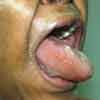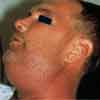Woman With Macroglossia, Weakness, Edema, and Dysphagia
For several months, a 60-year-old woman has had weakness, lower extremity edema, and dysphagia. She denies fever, chest discomfort, and rash.
The Case: For several months, a 60-year-old woman has had weakness, lower extremity edema, and dysphagia. She denies fever, chest discomfort, and rash.
The patient smokes cigarettes. She is mildly hypertensive and is currently taking lisinopril. Heart rate and rhythm are regular. She is afebrile. Respiration rate is 16 breaths per minute. Lungs are clear.
She has 2+ edema of the lower extremities. There is minimal weakness in all extremities, but the findings are nonfocal. No skin lesions are noted. The tongue is grossly enlarged and causes some alterations in speech. Dental examination reveals multiple caries. Moderate lymphadenopathy is present.

What is the most likely cause of this patient's symptoms?
• Angioedema
• Amyloidosis
• Ludwig angina
• Hypothyroidism
(Answer and discussion begin on next page.)
DISCUSSION: Results of a basic metabolic panel, complete blood cell count, and thyroid function testing, as well as ECG and radiographic findings, were normal. Urinalysis revealed significant proteinuria and monoclonal light chains; a serum electrophoresis revealed a mono-clonal immunoglobulin that was consistent with a plasma cell dyscrasia. Tongue biopsy results revealed amyloidosis. This disease is characterized by the extracellular deposition of insoluble proteins into various tissues and by secondary organ dysfunction.
Before the 1970s, amyloidosis was classified as either primary or secondary and as either localized or systemic; currently, classification is based on the type of protein that makes up the amyloid fibril. About 23 types of these proteins exist; all of them demonstrate rigid, nonbranching fibrillar structures under electron microscopy and bright green birefringence under polarized microscopy. The clinical features of amyloidosis vary according to the type of fibril present. This patient had amyloidosis light chain type (AL) attributable to a plasma cell dyscrasia.
Although any tissue or organ may be affected, the most common manifestations of amyloidosis include ankle edema, weight loss, weakness or fatigue, paresthesias, and light-headedness. Common physical findings are edema, macroglossia, purpura, orthostatic hypotension, and hepatosplenomegaly.
Macroglossia is the most frequent manifestation of the disease in patients with head and neck involvement. The enlarged tongue may be cosmetically disfiguring and can interfere with breathing, speech, and swallowing. Hemorrhage from tissue breakdown and sialorrhea are often present. Other head and neck manifestations include skin changes (eg, purpuric, waxy lesions around the upper eyelids) and nodules or polypoid lesions of the laryngotracheal system; the nasopharynx and thyroid gland may also be affected.
Although the history and clinical manifestations may suggest amyloidosis, the diagnosis must be confirmed with a tissue biopsy. Rectal biopsy-considered the gold standard in the past-has been replaced by needle biopsy of the subcutaneous fat, which has a reported 57% to 85% sensitivity and 92% to 100% specificity for various types of amyloidosis.
Systemic amyloidosis has a poor prognosis; the median survival after diagnosis ranges from 4 to 15 months. Failure of the cardiovascular and renal systems is the leading cause of death.
Prednisone and melphalan have been used, with relatively little success, to treat systemic amyloidosis. Surgical excision (ie, partial glossectomy) is somewhat more effective for localized disease, especially in patients with head and neck involvement. This patient refused treatment and was lost to follow-up.
DIFFERENTIAL DIAGNOSIS OF MACROGLOSSIA
Angioedema is a well-known cause of soft tissue swelling of the face, including the lips, tongue, soft palate, eyes, and earlobes. Classified as idiopathic, allergic, or hereditary, this disorder results from fluid leakage in the skin below the dermis and is characterized by well-demarcated, nonpitting edema. Various drugs are associated with angioedema, including angiotensin-converting enzyme inhibitors (most commonly), NSAIDs, radiocontrast agents, and opiates. Other inciting factors may include food allergies, localized trauma, stress, and postinfectious disorders or illness. Symptoms are usually acute and most often affect the extremities, face, and genitalia. Airway obstruction, the most serious complication of angioedema, needs to be emergently addressed. Treatment consists of corticosteroids, antihistamines, and-in severe cases-epinephrine.
Ludwig angina, a potentially life-threatening cellulitis of the submental, sublingual, and submandibular regions of the face, results in boardlike edema and elevation of the tongue, drooling, and airway obstruction (Figure). This often rapidly spreading cellulitis is odontogenic in 90% of cases and usually arises from the second and third mandibular molars. Trauma, upper respiratory tract infections, and sialedenitis are much less common causes.

Patients typically have dental or neck discomfort, dysphagia, trismus, and macroglossia. Although the diagnosis can often be made clinically, a neck CT scan with contrast may help delineate the extent of the disease.
Airway patency is the main concern in patients with Ludwig angina. Broad-spectrum intravenous antibiotics, such as penicillin and clindamycin, should be administered. Surgical incision and drainage is often necessary.
Hypothyroidism, the most common pathological hormone deficiency, may be either primary or secondary (caused by derangements of the pituitary or hypothalamus). Various metabolic disorders can result from inadequate thyroid hormone production. Myxedematous infiltration of tissue may affect the tongue (macroglossia), cardiac system (with resulting cardiomegaly or pericardial effusion), GI system (delayed GI transit, achlorhydria), and genital system (menstrual irregularities, delayed puberty, or anovulation). Cold intolerance, coarseness and puffiness of the skin, and decreased sweating are some of the classic signs and symptoms. Because most patients with hypothyroidism have nonspecific symptoms, the diagnosis must be confirmed by laboratory testing.
References:
FOR MORE INFORMATION:
• Effron D. Ludwig angina.
Consultant
. 2001;41:1193-1194.
• Jacobs P, Sellars S, King HS. Massive macroglossia, amyloidosis and myeloma.
Postgrad Med J.
1988;64:696-698.
• Schwartz RS, Cohen JR, Schrier SL. Therapy of primary amyloidosis with mephalan and prednisone.
Arch Intern Med.
1979;139:1144-1147.
• Severtson M, Petruzzelli GJ. Macroglossia.
Otolarygol Head Neck Surg.
1996;114:501-502.